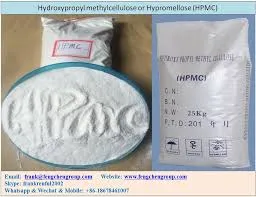
Ное . 01, 2024 04:45 Back to list
Exploring the Benefits and Applications of Hydroxypropyl Methylcellulose in Various Industries
Understanding Hydroxypropyl Methylcellulose Applications and Benefits
Hydroxypropyl methylcellulose (HPMC) is a semi-synthetic polymer derived from cellulose, a natural polymer found in plant cell walls. It is widely used in various industries due to its unique properties, including thickening, emulsifying, and film-forming capabilities. This article delves into the characteristics, applications, and benefits of HPMC, highlighting its significance in modern formulations.
Properties of Hydroxypropyl Methylcellulose
HPMC is a non-ionic cellulose ether, making it soluble in cold water and providing it with a wide range of viscosities. The degree of substitution, which refers to the number of hydroxyl groups replaced by hydroxypropyl and methoxy groups, influences its solubility and viscosity. Its ability to form gels also plays a crucial role in its functionality. Given these properties, HPMC is an excellent thickening agent, helping to stabilize emulsions and suspensions in various applications.
Applications in Pharmaceuticals
One of the most significant applications of HPMC is in the pharmaceutical industry. It is commonly used as a binder and film-forming agent in tablet formulations. By improving the cohesion of powders during the tablet compression process, HPMC helps ensure the integrity and disintegration of the tablets. Additionally, due to its gel-forming properties, HPMC is often used in controlled-release drug delivery systems, allowing for the gradual release of active ingredients over time. This controlled release is crucial for maintaining therapeutic levels in the bloodstream, enhancing efficacy while reducing side effects.
hydroxypropyl methylcellulose

Role in Food Industry
In the food sector, HPMC serves as a food additive, acting as a thickener and stabilizer. It is often used in sauces, dressings, and dairy products to improve texture and mouthfeel. Furthermore, because HPMC is non-toxic and can emulate the physical properties of fat, it becomes a valuable ingredient in low-fat or reduced-calorie foods, providing a similar texture without the added calories. This versatility is essential for manufacturers aiming to meet consumer demands for healthier food options without compromising on taste and quality.
Cosmetic and Personal Care Uses
HPMC is also prevalent in the cosmetic and personal care industries. It is used in formulations for creams, lotions, and gels, where it acts as a thickening agent and stabilizer. Its film-forming properties help in producing smooth, even textures in cosmetics, and it can enhance the consumer’s sensory experience. Furthermore, HPMC is compatible with a wide range of other ingredients, making it a popular choice for formulators aiming to create innovative cosmetic products.
Conclusion
In summary, hydroxypropyl methylcellulose is a versatile ingredient with vast applications across multiple industries, including pharmaceuticals, food, and cosmetics. Its unique properties, such as thickening, film-forming, and stabilizing abilities, make it an invaluable compound in modern formulations. As consumer demands for effective and safe products continue to grow, the significance of HPMC will likely expand, reinforcing its role as a vital component in various industries. As research and development advance, we can anticipate new innovations that leverage HPMC’s properties, further broadening its application scope.
-
Versatile Hpmc Uses in Different Industries
NewsJun.19,2025
-
Redispersible Powder's Role in Enhancing Durability of Construction Products
NewsJun.19,2025
-
Hydroxyethyl Cellulose Applications Driving Green Industrial Processes
NewsJun.19,2025
-
Exploring Different Redispersible Polymer Powder
NewsJun.19,2025
-
Choosing the Right Mortar Bonding Agent
NewsJun.19,2025
-
Applications and Significance of China Hpmc in Modern Industries
NewsJun.19,2025







